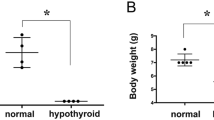Abstract
The EphA5 receptor has recently been known to play an important role in the initiation of the early phase of synaptogenesis, during which irreparable harm would be done to the developing brain in the absence of sufficient thyroid hormone (TH). In the present article, we aimed to analyze the characteristics of EphA5 receptor expression in the brain of congenital hypothyroid rats. The results showed that the levels of the EphA5 receptor were downregulated by TH deficiency in the developing rat brain with remarkable spatial and temporal characteristics. In the hypothyroid rats, the mRNA and protein levels of EphA5 receptor decreased significantly in the hippocampus (27.92–53.26 %), cerebral cortex (12.52–47.16 %), and cerebellum (8.72–31.69 %) compared with those in the normal rats from postnatal day 0 (P0) to P21 (p < 0.01). The expression of EphA5 receptor was highest and declined most as much as 53 % in the hippocampus with TH deficiency. At P7, the EphA5 receptor decreased most prominently during all the observed time point. Conclusion: The EphA5 receptor plays actively in the brain development in congenital hypothyroid rats. Our study highlights the high expression of EphA5 receptor protein in hippocampus and dramatic changes at P7 in condition of TH deficiency, which may provide important basis for further investigations in manipulating congenital hypothyroidism.




Similar content being viewed by others
References
Ahmed OM, El-Gareib AW, El-Bakry AM, Abd EI-Tawab SM, Ahmed RG (2008) Thyroid hormones states and brain development interactions. Int J Dev Neurosci 26(2):147–209
Akaneya Y, Sohya K, Kitamura A, Kimura F, Washburn C, Zhou R, Ninan I, Tsumoto T, Ziff EB (2010) Ephrin-A5 and EphA5 interaction induces synaptogenesis during early hippocampal development. PLoS One 5(8):e12486
Anderson GW, Schoonover CM, Jones SA (2003) Control of thyroid hormone action in the developing rat brain. Thyroid 13(11):1039–1056
Bernal J, Guadano-Ferraz A (2002) Analysis of thyroid hormone-dependent genes in the brain by in situ hybridization. Methods Mol Biol 202:71–90
Bush JO, Soriano P (2012) Eph/ephrin signaling: genetic, phosphoproteomic, and transcriptomic approaches. Semin Cell Dev Biol 23(1):26–34
Chao MC, Yang P, Hsu HY, Jong YJ (2009) Follow-up study of behavioral development and parenting stress profiles in children with congenital hypothyroidism. Kaohsiung J Med Sci 25(11):588–595
Cooper MA, Crockett DP, Nowakowski RS, Gale NW, Zhou R (2009) Distribution of EphA5 receptor protein in the developing and adult mouse nervous system. J Comp Neurol 514(4):310–328
de Escobar GM, Obregon MJ, del Rey FE (2004) Maternal thyroid hormones early in pregnancy and fetal brain development. Best Pract Res Clin Endocrinol Metab 18(2):225–248
Desouza LA, Ladiwala U, Daniel SM, Agashe S, Vaidya RA, Vaidya VA (2005) Thyroid hormone regulates hippocampal neurogenesis in the adult rat brain. Mol Cell Neurosci 29(3):414–426
Drescher U (2002) Eph family functions from an evolutionary perspective. Curr Opin Genet Dev 12(4):397–402
Feldheim DA, Nakamoto M, Osterfield M, Gale NW, Dechiara TM, Rohatgi R, Yancopoulos GD, Flanagan JG (2004) Loss-of-function analysis of EphA receptors in retinotectal mapping. J Neurosci 24(10):2542–2550
Henkemeyer M, Itkis OS, Ngo M, Hickmott PW, Ethell IM (2003) Multiple EphB receptor tyrosine kinases shape dendritic spines in the hippocampus. J Cell Biol 163(6):1313–1326
Himanen JP, Nikolov DB (2003) Eph receptors and ephrins. Int J Biochem Cell Biol 35(2):130–134
Horn S, Heuer H (2010) Thyroid hormone action during brain development: more questions than answers. Mol Cell Endocrinol 315(1–2):19–26
Kesner RP, Gilbert PE, Wallenstein GV (2000) Testing neural network models of memory with behavioral experiments. Curr Opin Neurobiol 10(2):260–265
Kullander K, Klein R (2002) Mechanisms and functions of Eph and ephrin signaling. Nat Rev Mol Cell Biol 3(7):475–486
Macchia PE (2000) Recent advances in understanding the molecular basis of primary congenital hypothyroidism. Mol Med Today 6(1):36–42
Oppenheimer JH, Schwartz HL (1997) Molecular basis of thyroid hormone-dependent brain development. Endocr Rev 18(4):462–475
Pasquale EB (2005) Eph receptor signaling casts a wide net on cell behavior. Nat Rev Mol Cell Biol 6(6):462–475
Porterfield SP, Hendrich CE (1993) The role of thyroid hormones in prenatal and neonatal neurological development—current perspectives. Endocr Rev 14(1):94–106
Rovet JF (2002) Congenital hypothyroidism: an analysis of persisting deficits and associated factors. Child Neuropsychol 8(3):150–162
Royland JE, Parker JS, Gilbert ME (2008) A genomic analysis of subclinical hypothyroidism in hippocampus and neocortex of the developing rat brain. J Neuroendocrinol 20(12):1319–1338
Schwartz HL, Ross ME, Oppenheimer JH (1997) Lack of effects of thyroid hormone on late fetal rat brain development. Endocrinology 138(8):3119–3124
Wong CC, Leung MS (2001) Effects of neonatal hypothyroidism on the expressions of growth cone proteins and axon guidance molecules related genes in the hippocampus. Mol Cell Endocrinol 184(1–2):143–150
Acknowledgments
This study was supported by the graduate innovation fund of Jiangsu Colleges and Universities (CXZZ12-0838) and the Nature Science Foundation of Nantong (BK2011051).
Conflict of interest
All the authors declare no conflict of interest.
Author information
Authors and Affiliations
Corresponding authors
Rights and permissions
About this article
Cite this article
Wu, Yj., Xu, My., Wang, L. et al. Analysis of EphA5 receptor in the developing rat brain: an in vivo study in congenital hypothyroidism model. Eur J Pediatr 172, 1077–1083 (2013). https://doi.org/10.1007/s00431-013-2008-5
Received:
Accepted:
Published:
Issue Date:
DOI: https://doi.org/10.1007/s00431-013-2008-5




